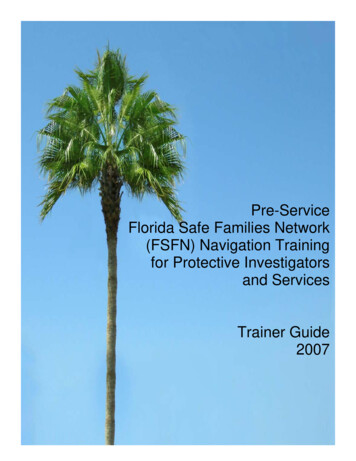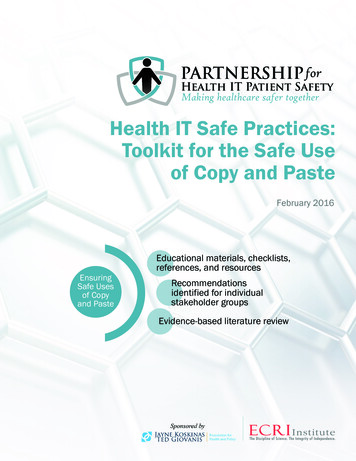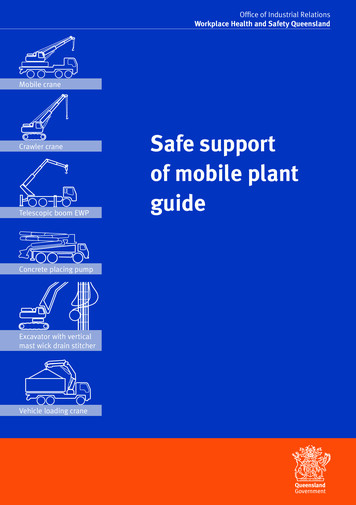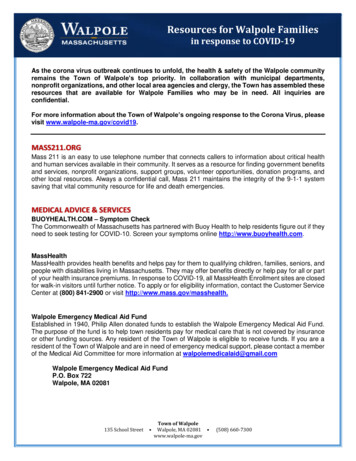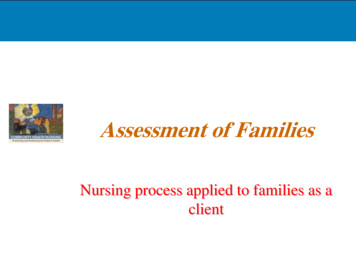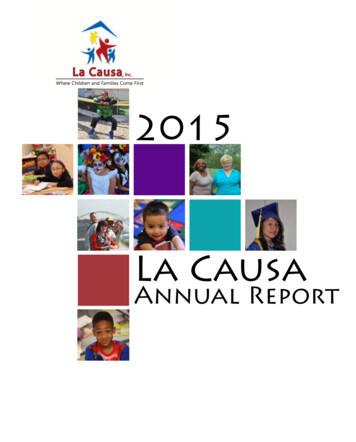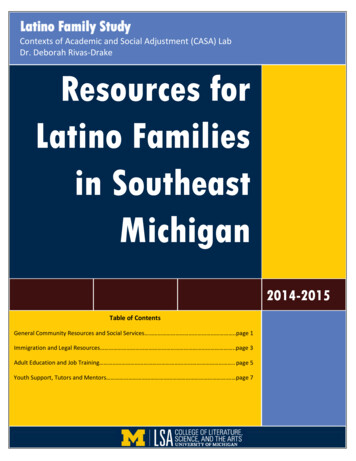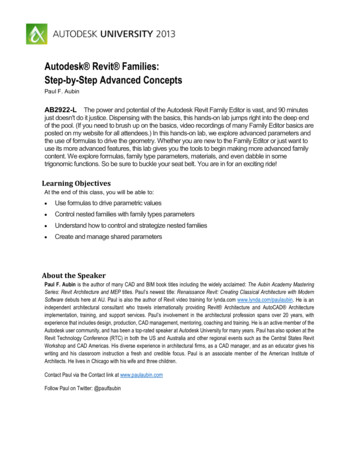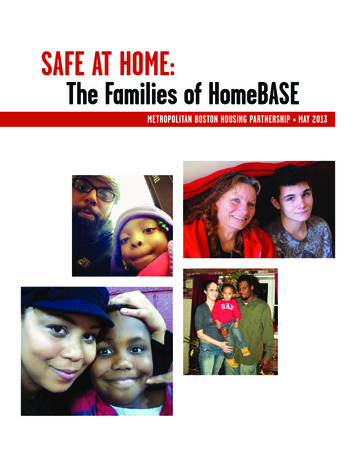
Transcription
SAFE AT HOME:The Families of HomeBASEMETROPOLITAN BOSTON HOUSING PARTNERSHIP MAY 2013
METROPOLITAN BOSTON HOUSING PARTNERSHIP (MBHP)MBHP is the state’s largest regional provider of rental housing voucher assistance, serving7,700 tenant households and working with 4,300 property owners. MBHP servesindividuals and families who are homeless, elderly, disabled, and/or of low and moderateincomes. MBHP’s region spans Boston and 29 surrounding communities.MBHP’s mission is to ensure that the region’s low- and moderate-income individuals andfamilies have choice and mobility in finding and retaining decent affordable housing; allMBHP programs and initiatives are designed to encourage housing stability, increaseeconomic self-sufficiency, and enhance the quality of the lives of those it serves. Toachieve its mission and to promote efficient service delivery, MBHP works collaborativelywith a broad array of service providers and neighborhood-based organizations.CONTRIBUTORS TO THIS PAPER INCLUDE:Christopher Blagg—MBHP Communications ManagerNoreen Dolan—MBHP Assistant Director of Housing SupportsSteven Farrell—MBHP Director of Special ProjectsElizabeth Jones—MBHP Grant WriterChristopher Norris—MBHP Executive DirectorACKNOWLEDGEMENTSMBHP would like to express our thanks to members of the MBHP ProgramCommittee for their advice and guidance, the entire Housing Supports team at MBHPfor their dedication and vast knowledge, and of course all the families who generouslyshared their stories and time to bring a personal perspective to this paper.Publisher’s Note: The conclusions and recommendations in this paper are those solely of Metropolitan Boston Housing Partnership. 2013 All rights reserved. For reprinting permission, contact the Communications Manager at MBHP at (617) 859-0400.
SAFE AT HOME: The Families of HomeBASEINTRODUCTIONToday, more than 5,000 families across Massachusetts, including1,400 families in the city of Boston and surrounding communities,live in safe and stable housing because of HomeBASE, theCommonwealth’s housing assistance program that is an alternativeto shelters and motels. However, these families’ housing situationsand the state’s investments are at risk. If nothing is done, programparticipants will begin to lose their rental assistance in July 2013.More than one-half of families will lose their assistance byDecember, and all 5,000 families will have lost their assistanceby June 30, 2014. Many of them will be back at the doors ofhomeless shelters.BACKGROUNDThe HomeBASE program, developed in July 2011, providesfinancial assistance to pay rent, utility bills, security deposits, andother expenses that allow a family to stay in their current home,move to new housing, or live with another family. HomeBASEalso provides services to help families secure more income, savemoney, comply with their leases, get health care, child care, andother basic services.The program has three goals:1) Support suitable housing for families who are homeless orare in shelters or motels;2) Use state resources more efficiently by reducing the overallcosts of assistance to address homelessness; andAt Metropolitan Boston Housing Partnership (MBHP), webelieve that everyone deserves a place to call home. This paper,Safe at Home:The Families of HomeBASE, gives a face and a voiceto our neighbors who are participating in the program. Theirstories, their challenges, and their successes provide a personallook at the people impacted by what might otherwise merely bediscounted as “state policy.” Families and their children shouldbe safe at home.3) Stabilize the lives of homeless families on a short-term basisso that they can handle rental payments on their own at the endof the benefit period.The experiences of participants suggest that the first two goalshave been met—but very few, if any, families will be able to paytheir rents independently at the end of the program.1
When launched in 2011, HomeBASE financial assistance forfamilies1 was touted as a less expensive option compared toemergency shelter or motels that cost approximately 100 perroom per night. It was meant to give families a reasonablealternative to entering emergency shelter by either using household assistance or up to three years of rental assistance. Before theimplementation of HomeBASE, almost 1,800 families were livingin motels because emergency shelter beds were full. By December31, 2011, six months after HomeBASE was created, that numberdropped to 1,309. The part of HomeBASE that was used toprovide housing—rental assistance—was obviously working well.For example, at its height, the program was assisting almost 2,000families in MBHP’s region by placing families that otherwisewould have been in the state shelter system into communitybased apartments. Participating families have an annual income averaging 10,140( 845 per month). 94% of the families are headed by females. The average age of the head of household is 32. The average total monthly housing costs for families in theHomeBASE program is 1,283. During their first year in HomeBASE, 55% of families increasedtheir incomes, bringing the average income for this group to 13,313 per year. This represents a 36% increase from the 9,7863average income at original enrollment.Perhaps more importantly, our data shows that if the rentalassistance ended today, 85% of participating families would havehousing costs in excess of their monthly income. Clearly, it is notpossible to pay more than 100% of your income for housing;therefore, these families will have their lives uprooted becausethey will not be able to stay where they are currently living.However, the demand for assistance was overwhelming. Therefore,in November 2011, the Administration and the Legislaturechanged the program and limited those eligible for rentalassistance. After that change, the number of families in motelssteadily increased, reaching 1,800 by November 2012. Since thattime, largely because of the expanded rental assistance optionsthrough the Massachusetts Rental Voucher Program and targetedoutreach to families in motels, the number of occupied motelrooms has been dropping, down to 1,200 in April 2013.WHERE ARE FAMILIES LIVINGThe loss of HomeBASE rental assistance will impact a broadswath of the metropolitan Boston area. MBHP administersHomeBASE rental assistance for families living in 26 differentcommunities. The largest number of families (1,030 or 73%) arein the city of Boston, with 87% of those in Roxbury, Dorchester,and Mattapan. More than 100 families with HomeBASE rentalassistance live in Chelsea. The cities of Everett, Malden, Medford,Quincy, Revere, Somerville, Winthrop, and Woburn also havedouble-digit numbers of participants.4In 2012, the HomeBASE program was amended again. As a resultof this change in the rules midstream, families who were originallytold they would receive up to three years of rental assistance andwho were already participating in the program were now toldthat they would only be eligible for up to two years of assistance.Taken together, the Commonwealth is investing 19 million ofHomeBASE rental assistance annually for homes in the 26communities, often in neighborhoods with high concentrationsof poverty (see figure 1 on facing page), money that will belost once HomeBASE rental assistance ends.Unless action is taken by the Legislature, families will run the riskof becoming homeless again and re-entering the more expensiveshelter system when their rental assistance expires.The average monthly rent levels for an available two-bedroomapartment in MBHP’s region on April 26 fall between 1,262 and 2,888. The affordability gap ranges from a low of 33,141 inReading to a high of 88,893 in Cambridge. Regardless of thecommunity, the average income of a HomeBASE participant isinsufficient to pay the average rent in any community.5WHO IS RECEIVING ASSISTANCE AT MBHP 2HomeBASE rental assistance specifically targets families with atleast one child who is 20 or younger and that are currently atrisk of homelessness or are living in a shelter or motel. Otherdemographics of MBHP HomeBASE families include: 86% of families have a child age 11 or under.1T he HomeBASE program includes three components: rental assistance, household assistance, and stabilization services.This paper focuses only on families who are receiving HomeBASErental assistance administered by Metropolitan Boston Housing Partnership.2A list of demographic data is in “Appendix A” on page 14.3T his figure is less than the average income of all participants because it is looking only at families who have been on the program for at least a year and who have recertified their eligibility tocontinue their participation.4A complete list of communities housing families with HomeBASE rental assistance administered by MBHP and the number of families in each community is in “Appendix B” on page 15.5A verage rent levels and the income needed to afford those rents is in “Appendix C” on page 16.2
amPOVERTY AND SUBSIDY LOSS FOR THE GREATER BOSTON AREANumber WhoCould Lose SubsidyPoverty Rate10 to 5.6 percent18.1 to 29.1 percent105.6 to 10.6 percent29.1 to 57.3 percent10010.6 to 18.1 percentFIGURE 1: Poverty and HomeBASE subsidy loss by zip code. Chart compiled by Tim H. DavisSources: MBHP Rental Assistance data and 2011 American Community Survey estimates3
OUTCOMES: WHAT HAS WORKEDAND WHAT HAS NOT WORKEDHomeBASE was originally touted as a “program of short-termhousing assistance” with the expectation that families would beable to assume their own rent payments when the program ended.The program was targeted to families with children who wereeligible for temporary emergency shelter. For families who haveparticipated in the program for at least a year, the average annualincome when they entered the program was 9,786. 65,880 49,512The short-term housing assistance has worked, with 2,000families obtaining housing in MBHP’s region. The stabilizationefforts of MBHP, its subcontractors, and shelter staff have alsobeen successful at addressing emergency situations and keepingpeople housed. To date, very few families have been terminatedfor cause (violating the lease, eviction, failure to recertify, violationof program requirements). 10,140Current averageMBHP HomeBASEparticipant incomefor all participantsObtaining jobs and an income to be self-sufficient has been lesssuccessful. In the 20 months from July 2011 through February2013 the unemployment rate in Massachusetts averaged 6.8%.Although down from the high of 7.4% during this period, jobswere and remain difficult to find, especially for applicants whodo not have a college degree.6 Still, 36% of families receivingHomeBASE rental assistance from MBHP are employed andhave income from wages at this time, but their incomes are notsufficient in our high-cost area.Income necessary toafford two-bedroomapartment at fairmarket rent (FMR)Economic independencethreshold(Source: CrittentonWomen’s Union)FIGURE 2: Gap between HomeBASE participant income andself-sufficiency measuresIn fact, in July 2012, MBHP’s HomeBASE Program Results for theMBHP Region August 2011—June 2012, stated, “[W]e are concernedabout what will happen at the end of 24 months of HomeBASERental Assistance. Few families are likely to see a substantialincome increase in the short-term, and without additional supportthey could lose their housing.” Unfortunately, it looks like thisprediction may become true, but it does not have to be that way.Additionally, in the Massachusetts Economic Independence Index 2013report released in March, Crittenton Women’s Union found thatin Massachusetts, one adult with a preschooler and one schoolage child would need to earn 65,880 for the family to meet itsmost basic needs. That figure was even larger in the areas servedby MBHP.RECOMMENDATIONSThere are a variety of options that can be taken to maintain thehousing stability and safety of families as well as the investmentthat the Commonwealth has already made.The barriers faced by families receiving HomeBASE rentalassistance coupled with the state’s unemployment rate andthe competition for scarce jobs, as well as the requirement ofspecialized training or higher education for most jobs thatpay a living wage made it unlikely that these families would reachthe goal of economic self-sufficiency within two years. In otherwords, although a few have succeeded, it was short-sighted tobelieve that a majority of families who were homeless, making 815 a month, and facing numerous other barriers would beable to dramatically increase their economic self-sufficiency injust a short period of time. R estore HomeBASE rental assistance to the 36 monthsthat was originally committed. This is the most expensiveoption because it would cost an additional 35 million, but itis the most effective and would be the least disruptive choicefor families. Instead, families would be able to remain in place,avoiding potential eviction and homelessness and allowing timeto find alternative and more tolerable solutions.7 Landlords whohave worked with MBHP to house the families would not beforced to undertake the difficult, expensive, and time consumingeviction process.6T his was confirmed by the Commonwealth Corporation and the Federal Reserve Bank of Boston last fall when in Labor Market Trends in the Boston/Metro North Region they said, “jobvacancies in the region tend to be most common among occupations where workers have higher levels of post-secondary education.”The report also said, “those with lower educationalattainment tend to be disproportionately represented among the unemployed.”7 It also costs less than the 120 million that would be required if 5,000 families enter emergency shelter and stay for eight months, the average stay at an emergency shelter, at a cost of 3,000 per month.4
C ontinue HomeBASE rental assistance for (or targetnew rental assistance resources to) families who are ineducational or job training programs or who havedisabilities that prevent them from working at a jobthat pays a living wage. Families who are investing in theireducation whether at school or training for a career could losethat investment if they lose their housing. If they do obtainwork upon completing their program, the amount of the rentalassistance will most likely decrease. Also, for families where thehead of household or a member of the household has a disabilitythat prevents them from obtaining a living wage, it will cost lessper month to have the family stably housed with rental assistancethan if they re-enter emergency shelter.CONCLUSIONThere are no easy answers and reasonable people can disagreeon the “right thing to do.” However, it is unfair to change rulesmidstream, and it is unfair to set unreasonable expectations whenresearch and data show that something is unlikely to work. It isalso clear that when housing resources are available, the numberof families who are homeless decreases, and it costs less per monthto provide rental assistance in a private apartment than to provideemergency shelter. Concentrating on solving homelessness and itsroot causes would be a more positive use of time than taking aBand-Aid approach. Massachusetts has many excellent housingprograms. By investing more deeply in these programs, we canhelp families achieve housing and provide the stability familiesneed to be successful. Restore families’ homelessness priority for public andsubsidized housing so that they are not penalized for havingparticipated in HomeBASE. HomeBASE was not meant to helpfamilies forever but rather to provide assistance for a limitedperiod of time. Restoring the homelessness priority will increasethe likelihood that families are able to obtain permanent housingthat they can afford.Families should not need to become homeless to accesshousing they can afford. And, if adequate funds are not goingto be made available to provide a long-term housing solutionfor those in need, that should be stated clearly by decisionmakers. Homelessness prevention services and resources shouldbe expanded to keep families in as stable a situation as possible.After all, everyone deserves a place to call home. E nsure that families who do lose their HomeBASErental assistance when the program ends are eligiblefor resources such as Residential Assistance for Familiesin Transition (a flexible, short-term funding programto prevent homelessness) or HomeBASE householdassistance and that they are not prevented from accessingemergency shelter.FAMILY CASE STUDIESIn the following pages are the true stories of eight families. Theirpersonal challenges and triumphs range from those who havesuccessfully transitioned from HomeBASE through education andemployment to those who continue to need assistance in arecession ravaged economy. These stories speak for themselves. F ocus on long-term housing rather than just avoidingshelter stays by increasing the supply of housing acrossa continuum (shelters, supportive housing, public housing,subsidized housing that is privately owned, and private rentalhousing) to meet the needs of all families. Ensure that familieswho are or were homeless are not prevented from accessingthis housing.5
Natascia: MaldenLOSS OF HOMEBASE IS A STEP BACKWARDS FOR MOTHER AND SON“I’ve already been through so much. I really don’t know what I’m going to doif it [HomeBASE] doesn’t continue. I just don’t want us to go backwards.”Homelessness can affect anyone. For Natascia, her housinginstability began with a horrific car accident that causedmyriad physical and mental disabilities. The repercussions ofthe accident hampered her ability to be self-sufficient and carefor her 7-year-old boy. Natascia suffers from severe nerve andspinal damage and frequent migraines, which has made regularemployment incredibly difficult because she has been unableto sustain multiple days of work at a time.happy. I feel like when you have your own place, of course youfeel good,” says Natascia. “Knowing your son is going to sleepwell is worth so much.”She remains tremendously grateful to MBHP and the rentalassistance she gets from the HomeBASE program. “HomeBASEhas been wonderful, even emotionally—they [MBHP caseworkers] check in on you, see how you are doing, are alwayslooking out for different resources,” says Natascia.For a few years, she was able to stay with her brother in a tinyone-bedroom apartment, with her and her son sleeping on afuton in the living room. As her son grew older and bigger, spacebecame more of an issue and her brother eventually asked themto leave. Faced with homelessness, Natascia turned to the stateand was referred to MBHP who successfully diverted her towardhousing with the state’s re-housing program (which eventuallyturned into HomeBASE rental assistance).Despite her disabilities and pain, Natascia volunteers at the localTransitional Assistance Office for short periods of time, and shecleans her local park on a regular basis—anything to feel like she’sable to give back to her community.Yet the threat of losing her HomeBASE rental assistance hascaused great anxiety. “I’ve already been through so much,”says Natascia. “I really don’t know what I’m going to do ifit [HomeBASE] doesn’t continue. I just don’t want us togo backwards.”Having her own apartment in her hometown of Malden, and herson having his own room has been a blessing. “Right now, I’m6
Ana Bela: DorchesterARMING HERSELF WITH EDUCATION IN THE FACE OF HOMEBASE TERMINATIONCaring for a severely disabled child can be a full-time job initself. Add two more children and a recession-fueled layoff,and it’s easy to see how Ana Bela and her family became homeless.Taking stock of her situation, Ana Bela enrolled
implementation of HomeBASE, almost 1,800 families were living in motels because emergency shelter beds were full. By December 31, 2011, six months after HomeBASE was created, that number dropped
